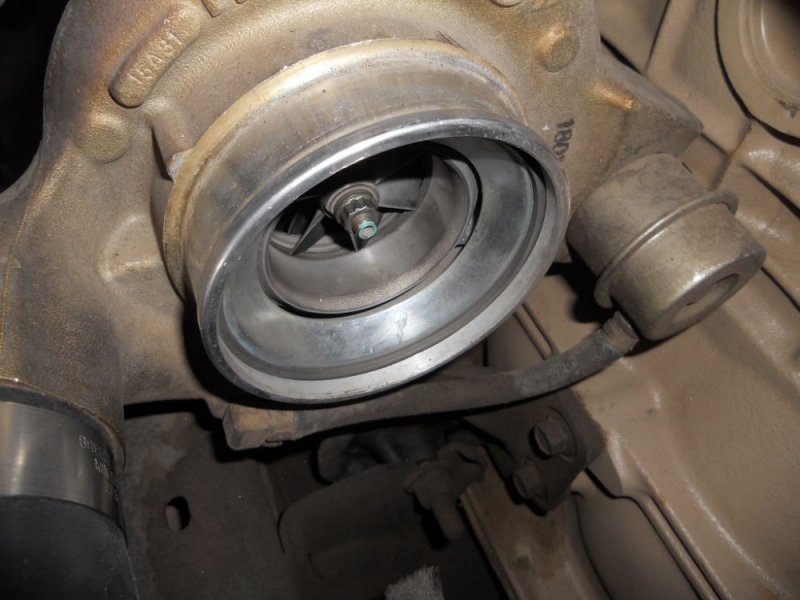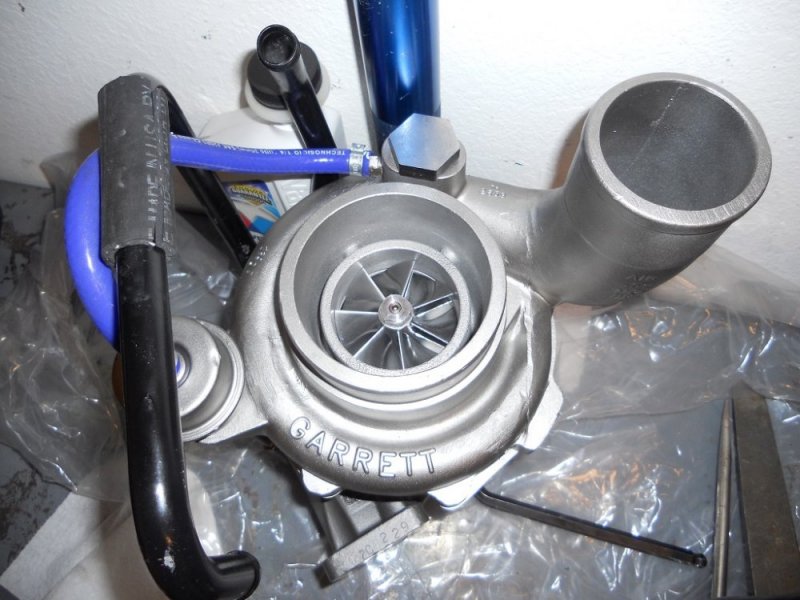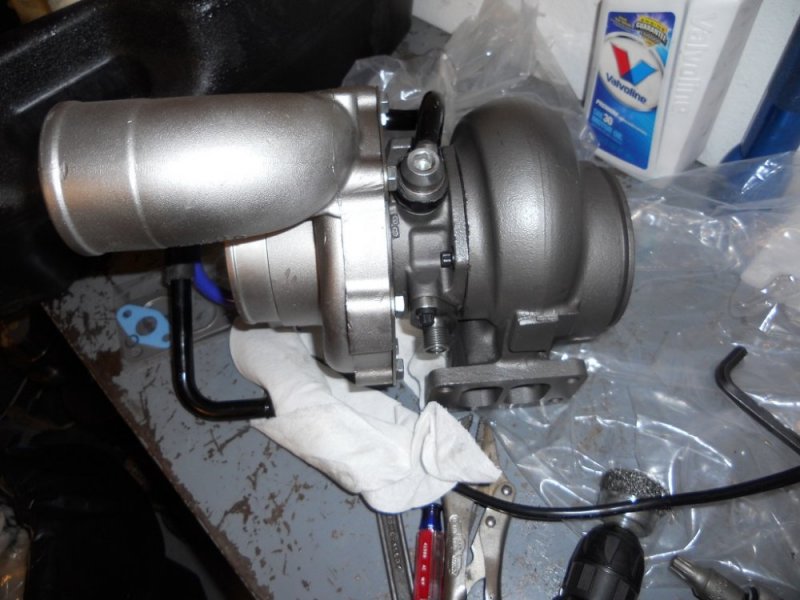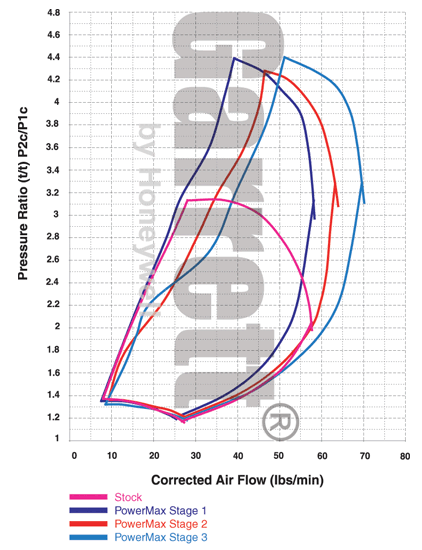The Garrett Powermax Stage 3 GT3788R Ball Bearing Turbo might be fun to try on a 6.5. It's long discontinued and is for the 5.9 diesels. Few still around out there. The 2nd gen turbo's have the compressor housing that would work better than the 3rd gen HPCR design below. The ball bearing takes less HP (friction loss via heating the oil in a JB) and spools up quicker than the same sized journal bearing (JB) turbo. Rumor is you can run a slightly larger BB turbo and have the same performance as a smaller JB turbo. Sound is supposed to be like the Knight Rider car... The drive pressure is documented to be lower than the stock turbo and that sold me to find one of these. They generally cost more than JB turbo's.
Anyway is there any reason the 5.9 Cummins turbo should survive 3 engine rebuilds? Yeah, turbo time as it's starting to rub the housing. I suspect it's blowing oil out the exhaust seal as well. Nevermind later 5.9's have a better turbo and, well, towing the 6.5 killer grade this turbo falls over some in high RPM.
Stock photo starting to rub:

So we pickup the last discontinued turbo available from a Garrett distributor, rebuilt, with 1 year warranty. (I made 1 phone call to check stock and the company I called did all the calling around for me and found some outfit with one in the back room.) It has a ball bearings and has a coolant cooled center section as the oil flow is way down. The oil feed is like an AC orface tube restricted as the ball bearings don't need much oil. Thus the need for coolant. Of course stage 1 is simply too small, Stage 2 is highly recommended and Stage 3 is for high RPM lovers like me. It's also the only stage that was available to me... ( All three stages are also known as GT3782R , but, stage 3 is a true GT3788R.)


The install is going to be a PIA as the two 5/8" to 1" heater hose adapters are missing. I already emailed Evans about turbo heat coking their coolant. They assure me it will be ok.
Of course this needs all the trimmings to take full advantage of "Stage 3" like a Smarty Touch tuner and EGT probe as Cummins will s#it a valve seat out of the head if you run EGT too high. I have to limit the HP to 425 and torque to 900 as that's all the South Bend Clutch I have will hold.
 Now taking the 305 HO engine to 395 HP and raising the RPM defuel to 3400 from 3200 already is fun on the stock turbo. We have the 110# valve springs and Hamilton cam from the rebuild already in so time to take advantage of that.
Now taking the 305 HO engine to 395 HP and raising the RPM defuel to 3400 from 3200 already is fun on the stock turbo. We have the 110# valve springs and Hamilton cam from the rebuild already in so time to take advantage of that.
Just got to be careful of the surge area and barking it...

Description- 2002.5 - 2007 5.9L Cummins Engine
- The GT37R dual ball-bearing turbo
- A Garrett exclusive ball bearing cartridge for unbeatable response, efficiency, and durability. Elimination of the thrust bearing eliminates Failures at elevated boost levels
- The upgrade results in lower intake and exhaust gas temperatures as well as reduced backpressure for more efficient air flow
- Water-cooled center section with a patented dual ball-bearing center section results in higher durability and longer turbo life
- Oil inlet fitting features a built in restrictor for worry-free operation
- High flow compressor wheels move air quickly and powerfully
- Maximum recommended boost is 40 psi
Garrett Stage 1 Horsepower 475*
Garrett Stage 2 Horsepower 510*
Garrett Stage 3 Horsepower 560*
* Estimated. Performance results of this product are highly dependent upon your vehicle's modifications and tuning/calibration. The horsepower numbers represented above are calculated based strictly on choke flow of the compressor map (total turbo capability), which represents the potential flywheel horsepower.
Anyway is there any reason the 5.9 Cummins turbo should survive 3 engine rebuilds? Yeah, turbo time as it's starting to rub the housing. I suspect it's blowing oil out the exhaust seal as well. Nevermind later 5.9's have a better turbo and, well, towing the 6.5 killer grade this turbo falls over some in high RPM.
Stock photo starting to rub:

So we pickup the last discontinued turbo available from a Garrett distributor, rebuilt, with 1 year warranty. (I made 1 phone call to check stock and the company I called did all the calling around for me and found some outfit with one in the back room.) It has a ball bearings and has a coolant cooled center section as the oil flow is way down. The oil feed is like an AC orface tube restricted as the ball bearings don't need much oil. Thus the need for coolant. Of course stage 1 is simply too small, Stage 2 is highly recommended and Stage 3 is for high RPM lovers like me. It's also the only stage that was available to me... ( All three stages are also known as GT3782R , but, stage 3 is a true GT3788R.)


The install is going to be a PIA as the two 5/8" to 1" heater hose adapters are missing. I already emailed Evans about turbo heat coking their coolant. They assure me it will be ok.
Of course this needs all the trimmings to take full advantage of "Stage 3" like a Smarty Touch tuner and EGT probe as Cummins will s#it a valve seat out of the head if you run EGT too high. I have to limit the HP to 425 and torque to 900 as that's all the South Bend Clutch I have will hold.
Just got to be careful of the surge area and barking it...

Description- 2002.5 - 2007 5.9L Cummins Engine
- The GT37R dual ball-bearing turbo
- A Garrett exclusive ball bearing cartridge for unbeatable response, efficiency, and durability. Elimination of the thrust bearing eliminates Failures at elevated boost levels
- The upgrade results in lower intake and exhaust gas temperatures as well as reduced backpressure for more efficient air flow
- Water-cooled center section with a patented dual ball-bearing center section results in higher durability and longer turbo life
- Oil inlet fitting features a built in restrictor for worry-free operation
- High flow compressor wheels move air quickly and powerfully
- Maximum recommended boost is 40 psi
Garrett Stage 1 Horsepower 475*
Garrett Stage 2 Horsepower 510*
Garrett Stage 3 Horsepower 560*
* Estimated. Performance results of this product are highly dependent upon your vehicle's modifications and tuning/calibration. The horsepower numbers represented above are calculated based strictly on choke flow of the compressor map (total turbo capability), which represents the potential flywheel horsepower.
Last edited:
